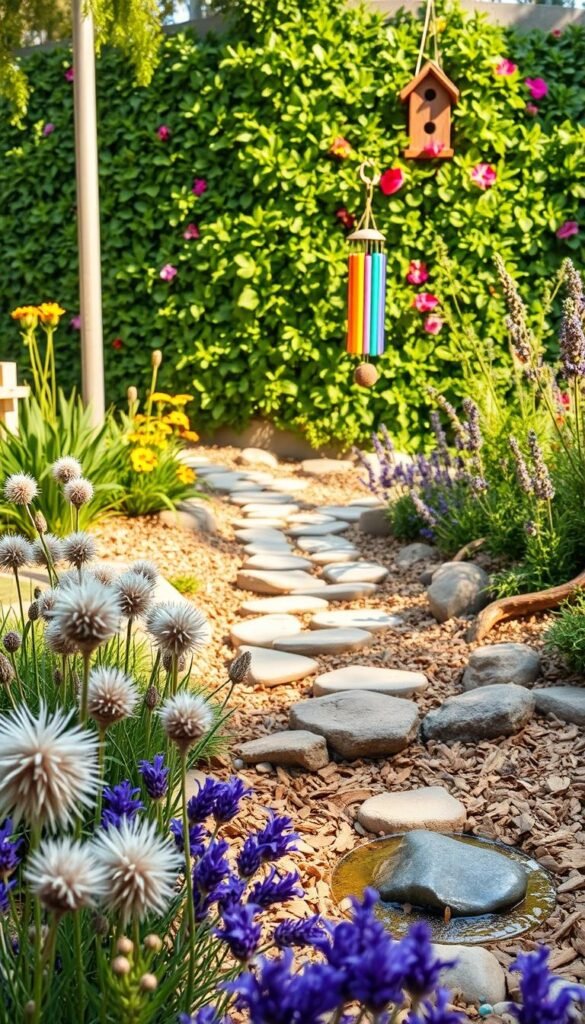Imagine transforming an ordinary outdoor space into a vibrant world where young minds connect with nature. Interactive gardens designed for children spark wonder through textures, scents, and sounds, turning playtime into meaningful exploration. Research shows these spaces boost cognitive growth, emotional awareness, and teamwork skills while nurturing a love for the environment.
Whether you’re planning a backyard project or enhancing a daycare area, these environments do more than entertain. They become classrooms without walls, where kids dig into soil, marvel at blooming flowers, and listen to rustling leaves. Studies reveal that hands-on interaction with natural elements strengthens problem-solving abilities and physical coordination.
Looking for inspiration? Pair fragrant herbs like lavender with crinkly ornamental grasses to engage multiple senses. Add wind chimes or a small water feature for auditory stimulation. For structured learning, explore our engaging lesson plans that blend gardening with early childhood education.
Beyond play, these spaces teach responsibility as children care for plants and observe growth cycles. They also create safe zones for independence-building—think stepping stones that challenge balance or hidden “discovery corners” that reward curiosity. Ready to craft a space where laughter mixes with learning?
Understanding the Benefits of a Sensory Garden for Kids
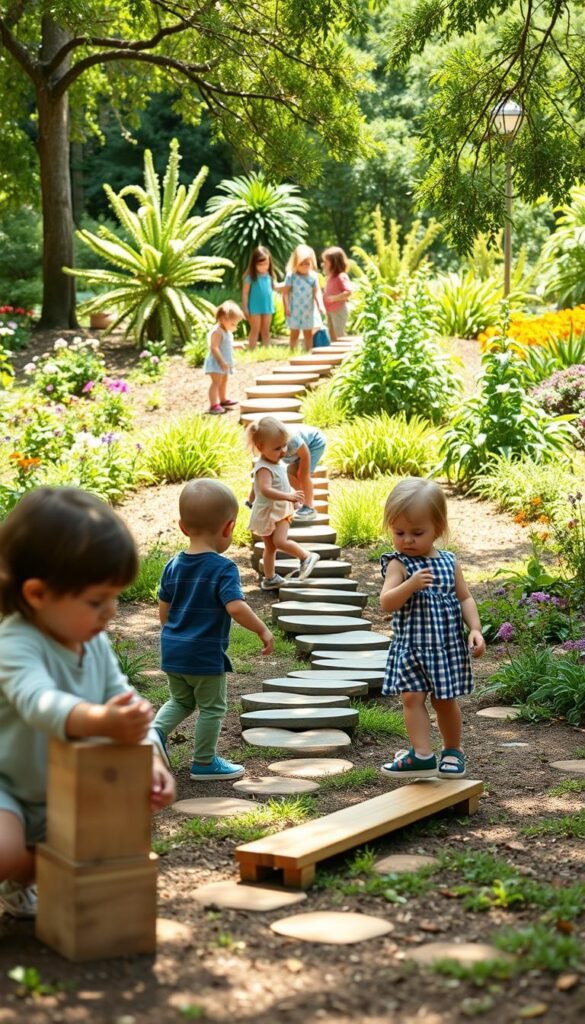
Outdoor spaces designed for hands-on discovery offer more than fresh air—they shape how young minds grow. These environments let kids practice motor skills while building confidence through play. Let’s explore how purposeful design supports physical and emotional milestones.
Boosting Physical and Motor Skills
Activities like digging or balancing on stepping stones challenge bodies in fun ways. Grasping seeds or watering cans refines finger coordination, while pushing wheelbarrows builds core strength. Over time, these actions improve agility and endurance naturally.
Encouraging Cognitive and Emotional Growth
When kids touch fuzzy leaves or smell herbs, their brains connect sensations to real-world knowledge. Observing butterflies or sprouting seeds teaches cause-and-effect thinking. Calm corners with wind chimes or soft grasses also help manage big feelings safely.
| Skill Type | Activities | Outcomes |
|---|---|---|
| Gross Motor | Climbing logs, carrying pots | Stronger muscles, better balance |
| Fine Motor | Planting seeds, using kid-sized tools | Precise hand movements |
| Emotional | Quiet sensory zones | Improved self-regulation |
For more ways to blend movement with learning, try these outdoor sensory activities. They turn ordinary play into skill-building adventures!
Simple Sensory Garden Ideas for Curious Little Explorers: A How-To Guide

Begin by sketching your space like a treasure map. Even compact patios can host discovery zones when planned creatively. Divide your area into five sensory stations—sight, sound, touch, smell, and taste—connected by winding paths that spark adventure.
Getting Started with Basic Design Principles
Mix structured and wild spaces for balanced exploration. Raised beds with snap peas create organized growing areas, while log piles and sand pits invite imaginative play. Keep pathways at least 24 inches wide for easy navigation. Pro tip: Use colored gravel to mark zones—blue for water play, yellow for aromatic herbs.
- Position rustling bamboo near wind chimes for layered sound experiences
- Include open-ended elements like movable stepping stones
- Leave “blank canvas” areas where kids can rearrange natural materials
Choosing Child-Friendly Materials
Opt for cedar planks over pressure-treated wood—they’re splinter-resistant and chemical-free. When selecting plants, the Lamb’s Ear offers velvety textures, while mint delivers safe scent exploration. Avoid pebble mulch (choking hazard) and choose rubber-edged sandboxes instead.
“Durability matters. Materials should survive mud pies and monsoon play.”
Store kid-sized tools in lockable bins near adult supplies. This teaches responsibility while preventing accidents. Rotate elements seasonally—swap winter evergreens for spring sunflowers to maintain curiosity.
Designing Your Sensory Garden Space Safely
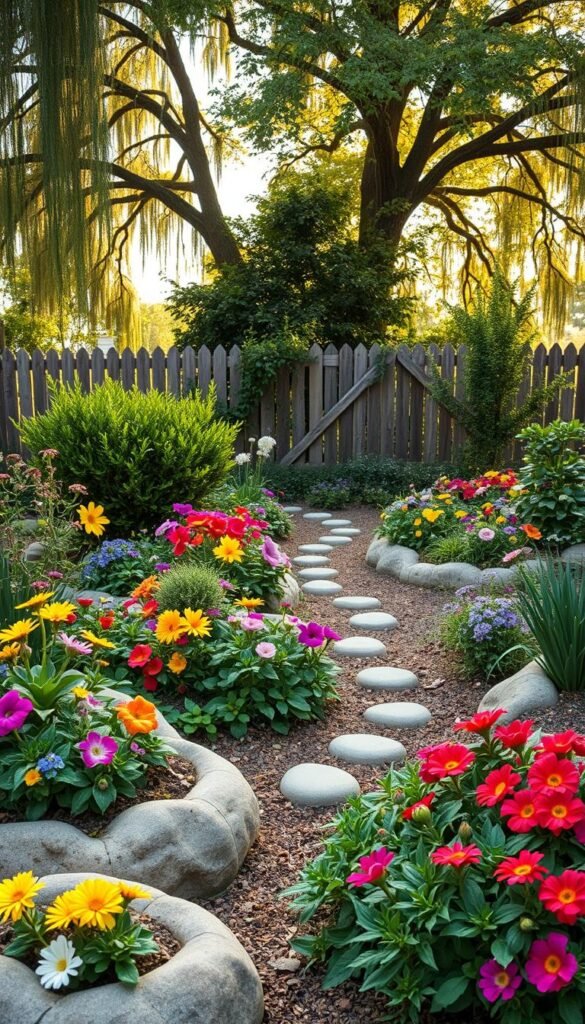
Creating a secure sensory space starts with smart design choices that protect while they inspire. Your layout should balance exploration with clear boundaries, letting kids investigate freely while minimizing risks. Start by evaluating every element through a safety lens—from soil composition to play structure materials.
Safe Plant Selections and Non-Toxic Options
When selecting plants, prioritize species that won’t harm curious taste-testers. Mint leaves make excellent sniff-and-touch specimens, while sunflowers offer edible seeds under supervision. Always cross-check the ASPCA’s toxic plant list before finalizing your greenery.
| Safe Choices | Avoid These | Why It Matters |
|---|---|---|
| Lamb’s Ear | Foxglove | Non-toxic vs. poisonous flowers |
| Marigolds | Oleander | Hypoallergenic vs. skin irritants |
| Basil | Daffodil Bulbs | Edible vs. toxic if ingested |
“A child-friendly garden isn’t about removing nature’s surprises—it’s about curating them thoughtfully.”
Creating Secure Play Zones
Define activity areas using knee-height log borders or colorful rubber edging. These visual cues help children understand where digging or running is appropriate. For ground cover, opt for:
- Shredded bark mulch (avoids splinters)
- Play-grade sand (washed and sifted)
- Foam tiles under climbing structures
Inspect your garden weekly for new hazards like broken branches or exposed roots. Teach kids to wash hands after touching soil and to ask before sampling any plant. With these precautions, your space becomes both a playground and a protected learning lab.
Engaging the Five Senses Through Garden Elements
Every corner of your outdoor space can become a gateway to discovery when designed with intentional sensory elements. By thoughtfully arranging colors, surfaces, and natural features, you craft an environment where kids connect with nature through direct experience.
Visual Delights and Tactile Textures
Bright marigolds and towering sunflowers become living rainbows that draw eyes upward. Pair them with silvery artemisia or purple sage for striking contrasts. Textured plants like lamb’s ear invite fingertips to explore fuzzy surfaces, while smooth river rocks offer cool resting spots.
Mix these with unexpected materials:
- Crinkly seed pods that snap when squeezed
- Bark rubbings that reveal hidden patterns
- Mirrored ornaments doubling flower displays
Auditory and Olfactory Inspirations
Wind-activated elements turn breezes into music. Bamboo chimes create soft tones, while dried gourds filled with beans rattle when shaken. Fragrant herbs like lemon balm release citrusy scents as kids brush past them during play.
Layer these sound and smell experiences:
| Sound Source | Scent Provider | Interaction Style |
|---|---|---|
| Rustling grasses | Pineapple mint | Gentle touch |
| Burbling fountain | Honeysuckle | Close observation |
Quiet nooks with cushioned seating let young explorers process these multisensory inputs. Rotate elements seasonally to maintain curiosity—swap spring hyacinths for autumn cinnamon ferns.
Incorporating Interactive Features and Play Elements
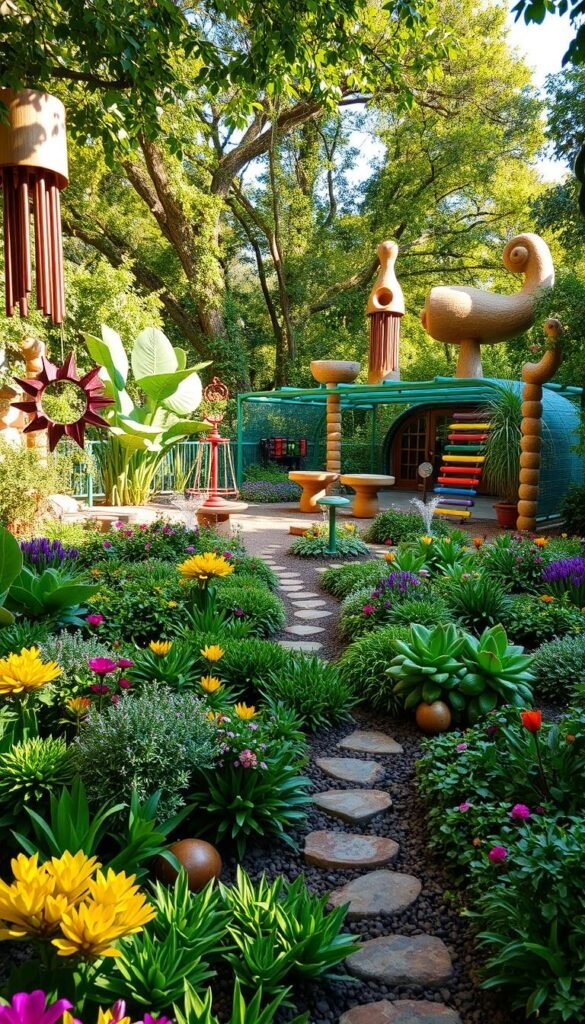
Transform playtime into an adventure by weaving interactive elements into your outdoor space. These features turn ordinary areas into discovery hubs where kids learn through hands-on experimentation. Let’s explore how movement, sound, and touch combine to create lasting memories.
Water Features, Wind Chimes, and Movement Paths
Start with gentle water features like shallow fountains or spill-proof tables. These provide safe splashing zones while teaching cause-and-effect relationships. Pair them with non-slip surfaces to prevent slips during enthusiastic water play.
Hang wind chimes crafted from bamboo or recycled metals near seating areas. Their melodies shift with breezes, encouraging kids to track wind patterns. For extra engagement, let children paint chimes before installation.
Design winding pathways using:
- Stepping stones spaced for hopping challenges
- Balance beams made from sanded logs
- Textured tiles alternating between smooth and bumpy surfaces
Add sensory panels with spinning gears or sliding beads along these routes. These features become pit stops for finger gymnastics and problem-solving games.
“Dynamic play environments don’t need complexity—just thoughtful combinations of nature and creativity.”
Rotate seasonal surprises like buried “treasure stones” or hanging seed pods that rattle in the wind. These hidden elements keep play fresh across visits. Always position water features and wind chimes near adult supervision zones for safety.
With these strategies, your space becomes a living laboratory where every splash, chime, and step sparks new discoveries.
Inclusive and Accessible Garden Design for Every Child
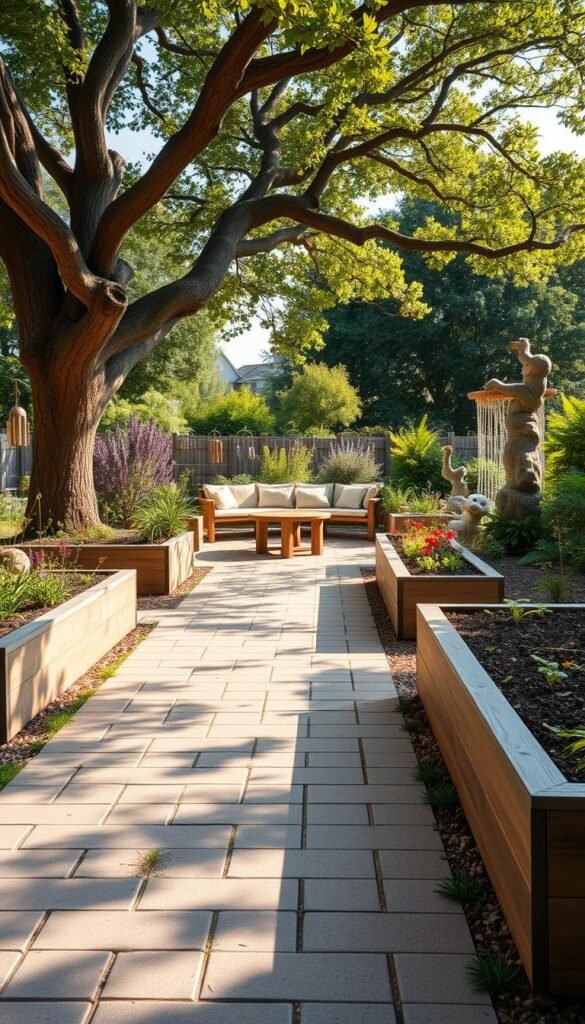
A truly welcoming outdoor space invites every child to explore, learn, and grow without barriers. Thoughtful design choices ensure kids of all abilities can dig, touch, and discover alongside peers. Start by reimagining your layout through universal principles that prioritize equal access and multisensory engagement.
Designing for All Abilities
Wide pathways (at least 36 inches) let wheelchairs maneuver easily while allowing groups to gather. Combine smooth pavers with rubberized borders for tactile contrast. Raised planters at varying heights bring soil-level activities within reach—try adjustable troughs that tilt for easier access.
Install sensory panels vertically on fences or low walls. Include elements like spinning gears, chimes, and textured tiles at multiple heights. This approach lets children interact whether they’re seated, standing, or using mobility aids.
Adjusting Pathways and Interactive Panels
Choose firm surfaces like decomposed granite or poured rubber for pathways. These materials prevent wheels from sinking while offering gentle resistance for walking practice. Add interest with embedded stepping stones that create pattern games—hopscotch meets texture exploration.
Interactive stations thrive when placed at 24″ and 36″ heights. Try these combinations:
- Lower panels: Water pumps, sand trays, and velcro-attached nature specimens
- Upper panels: Mirror mosaics, pulley systems, and aromatic herb gardens
“Accessibility isn’t an add-on—it’s the foundation of meaningful play spaces.”
Include shaded benches with armrests near activity zones. These resting spots let children observe or recharge before diving back into sensory garden ideas. With smart adjustments, your space becomes a launchpad for shared adventures.
Creative Plant Selections and Unique Garden Activities
Cultivating curiosity starts with plants that surprise and delight young explorers. By mixing tasty edibles with hands-on discovery stations, you transform ordinary greenery into interactive classrooms. Let’s explore nature’s tastiest teachers and the adventures they inspire.
Lemon Sorrel, Cucamelons, and Edible Varieties
Lemon sorrel becomes an instant favorite with its zesty leaves perfect for plucking and sampling. Kids love hunting for its tiny seeds using magnifiers—a sneaky way to practice observation skills. Pair it with cucamelon vines that produce grape-sized fruits resembling mini watermelons. Their crisp cucumber flavor turns harvests into flavorful treasure hunts.
Don’t forget husk cherries! These paper-lantern fruits let children unwrap sweet surprises while learning about seed protection. For continuous engagement, blend these edible plants with fragrant herbs like chocolate mint or pineapple sage.
Interactive Plant Activities That Spark Curiosity
Create “mystery seed” stations where kids match sprouts to adult plants. Build texture trails with lamb’s ear and snapdragon flowers that “talk” when squeezed. Incorporate watering challenges using marked cups to teach measurement—bonus points for rainbow-colored containers!
Looking to expand your space? Discover more tips in our guide on how to create a sensory garden in. These strategies turn every leaf and petal into pathways for joyful learning.

